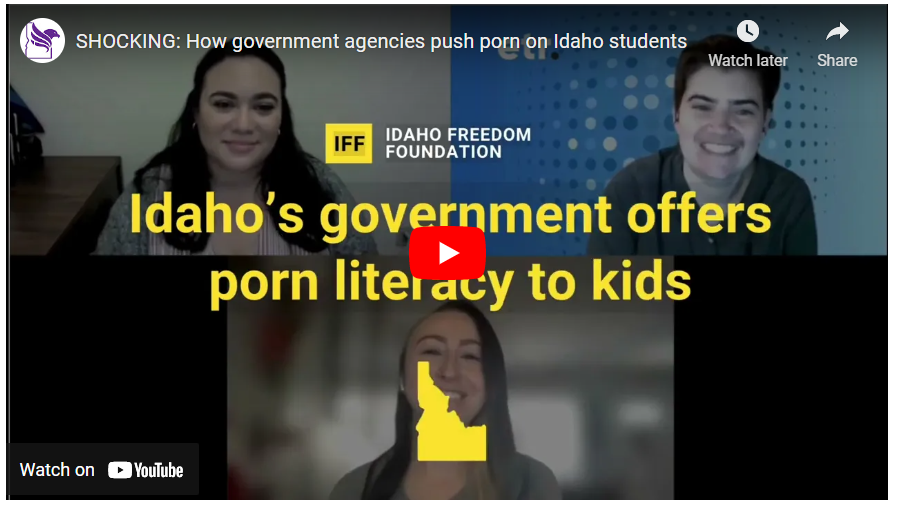
IDAHO’S GOVERNMENT OFFERS “PORN LITERACY,” OTHER CORRUPTING PRACTICES TO K-12 STUDENTS
By Anna Miller & Dr. Scott Yenor
Idaho’s Department of Health and Welfare (IDHW) implements sex education curriculum endorsed by Planned Parenthood in schools. The curriculum and training for sex education facilitators is purchased from an interest group that promotes queering education and normalizing the consumption of pornography.
Idaho law requires sex education taught in public schools to reinforce traditional family arrangements. IDHW promotes what Idaho law prohibits, however. IDHW takes funds from federal programs like the Personal Responsibility Education Program (PREP) and Title V Sexual Risk Avoidance Education (SRAE). Then, IDHW acquires sex education products from non-profits like Education, Training and Research (ETR), whose curriculum is developed and endorsed by Planned Parenthood.
Next, IDHW instructs public health districts to implement ETR’s Reducing the Risk (RTR) curriculum in public schools.
ETR’s Reducing the Risk curriculum promises to teach abstinence. Instead, ETR delivers a variety of approaches, including a “LGBTQ Inclusive” curriculum that queers education with an emphasis on “gender identity, sexual orientation and behavior.” ETR also advocates for teaching elementary students about “porn literacy,” which involves instruction on “kink and power, pleasure, sexual identity, sexual acts, and sexual exploration in relation to pornography.”
For ETR, pornography consumption is a “required topic” in sex education. Though, as ETR admits, “the evidence is largely unclear whether sexually explicit media use influences future sexual health among adolescents.” Introducing graphic sexual content into elementary schools creates opens minds and prepares students for sexual activity.
In an ETR-sponsored training titled “Porn Literacy in Sex Ed,” Sarah Diamond, Associate Director of Prevention and Education at the University of San Diego, hopes sex educators avoid stigmatizing porn as bad but rather “help students reflect on their own values about pornography.” Diamond suggests administering “porn literacy values” surveys and recommended activities wherein students defend ideas like “pornography can be a good way to learn about sex,” even if they disagree.
Another sex education facilitator, Jess Melendez, Adolescent Programs Health Educator at San Ysidro Health Teen Clinic, asserts in a training video that porn literacy should start in elementary schools with “intimate safety conversations.” In middle school, students should be able to “identify sexually explicit media and pornography.” High schoolers should be schooled in finding out “how can porn that depicts racism be harmful to a viewer.”
Other ETR-recommended “porn literacy” activities include having kids watch the AMAZE Org video “Porn: Fact or fiction” in which cartoon characters act out sexually explicit scenes. One young girl screams: “Wow! That’s so big. I never knew it could be so huge!” The sexual innuendo is followed by cartoon characters performing sexual acts. Porn is normalized to middle schoolers so sexual activity will be normalized, since, as the video contends, “being curious about sex or looking at pictures or films of naked bodies or people engaging in sexual behaviors is perfectly normal.”
In another ETR training video titled “Queering Sex Ed,” Planned Parenthood representative Laura Gardner explains how curriculum like RTR can already be considered “LGBTQ inclusive.” Important elements of “LGBTQ inclusive” sex ed include “adding a mention of a same sex relationship,” “using the word partner,” or “incorporating gender neutral names and language into scenarios and skits.” Pregnancy lessons should include discussions on “adoption or Ivf surrogacy” or “adding intersex to an anatomy lesson or adding puberty blockers to a puberty lesson.” For example, ETR’s Reducing the Risk curriculum includes gender neutral names and language in role plays of sexual encounters.
ETR’s radical curriculum spreads into Idaho schools through health districts. Idaho North Central Public Health District, for example, which serves Lewiston, Moscow, Orofino, Grangeville, and Kamiah, implements RTR in local schools.
A RTR curriculum link on the health district’s website directs viewers and teachers to ETR’s trainings on Porn Literacy and Queering Sex Ed.
The North Central Health District’s website directs teens to several other resources endorsed by this government-financed interest group. The National Campaign to Prevent Teen Pregnancy link takes kids to Power to Decide, showing kids where to get an abortion. Another link provided by the district is Love is Respect, which introduces kids to topics like polyamory and gender transitions. The Sex etc. link takes students to articles such as Transgender Men Can Get Pregnant, Too, surveys about masturbation, and AMAZE Org videos featuring cartoon depictions of porn and abortion.
Health districts are working to introduce the RTR curriculum into more schools. According to the 2018-2022 strategic plan of Central District Health, which serves Ada, Boise, Elmore, and Valley counties, RTR is being implemented in schools in three of the four counties it serves.
It’s unlikely that the IDHW is unaware of the radical intent behind the RTR curriculum since its own website directs viewers to Planned Parenthood clinics.
No one can say how many school districts in Idaho have adopted this curriculum, though nearly every health district promotes the RTR curriculum.
Sometimes Planned Parenthood clinics offer the program in schools. Beginning in 2015, Planned Parenthood of the Great Northwest delivered ETR curriculum in Caldwell, Idaho, in high schools and school-based health centers. Idaho school districts are not required to announce their adoption of this or any other curriculum.
Federal grants complicate the tasks of state governments. They offer “free” money with federal strings. Money for pregnancy prevention ultimately means money for queering the curriculum and promoting porn literacy through a federal bait-and-switch. Not only can citizens demand that their school districts refuse to use these state-recommended resources, but legislators can analyze federal programs with stricter scrutiny to ensure that they do not corrupt the state’s children.
Anna Miller is education policy director at the Idaho Freedom Foundation’s Center for American Education. Follow her on Twitter at @annakate_miller. Scott Yenor is a Washington Fellow at the Claremont Institute’s Center for the American Way of Life. Follow him on Twitter at @scottyenor.
From idahofreedom.org

